Discover the Variety of Dental Issues Dentists Frequently Deal With
Dental practitioners are entrusted with attending to a broad range of oral issues, each needing specialized knowledge and methods. From the prevalent trouble of dental caries caused by microbial task to the a lot more perilous progression of gum tissue condition, dental professionals should be proficient at early detection and treatment. Tooth level of sensitivity, usually arising from worn enamel, includes one more layer of complexity, while the early recognition of oral cancer can be life-saving. Furthermore, misaligned bites necessitate personalized treatment plans to boost both functionality and appearances. What certain approaches do dental practitioners employ to handle these varied obstacles efficiently?
Dental Caries and Dental Caries
Cavities, likewise understood as dental caries, are triggered by the demineralization of tooth enamel due to acid-producing germs in the mouth. If left neglected, dental caries can lead to considerable dental issues, including infections and tooth loss.
To diagnose tooth cavities and tooth decay, dental professionals use a mix of aesthetic evaluations, oral X-rays, and often laser fluorescence tools. For more sophisticated decay, a dental expert may need to remove the jeopardized cells and bring back the tooth with fillings made from products such as composite resin, amalgam, or porcelain.
Safety nets are vital in combating cavities and tooth degeneration. Regular oral examinations, appropriate cleaning and flossing strategies, and a well balanced diet plan reduced in sugary foods and beverages are fundamental practices that support dental wellness and lessen the risk of oral decays.
Gum Tissue Illness

This causes the periodontals to pull away from the teeth, creating pockets that come to be contaminated. As the body's immune system fights the microorganisms, the bone and connective tissue that hold teeth in location are damaged down.
Dentists detect gum illness through medical assessment and gum probing to measure pocket midsts around the teeth. Treatment may entail scaling and root planing to eliminate tartar and microorganisms from tooth surface areas and below the gum tissues.

Tooth Level Of Sensitivity
Beyond gum tissue illness, one more usual dental concern that people frequently run into is tooth sensitivity. Defined by a sharp, transient pain in reaction to stimuli such as hot, chilly, pleasant, or acidic foods and beverages, tooth sensitivity can considerably influence a patient's lifestyle - dentists eugene. This problem usually arises when the safety enamel layer of the teeth becomes worn down or when the gum tissues recede, revealing the underlying dentin. Dentin contains tiny tubules that connect to the nerve endings within the tooth, thereby transmitting the uncomfortable feelings.
In addition, oral procedures, cracked teeth, and gum disease can expose the dentin. To minimize tooth sensitivity, dental professionals may recommend using toothpaste developed for sensitive teeth, fluoride therapies to strengthen enamel, or dental bonding to cover revealed dentin.
Ultimately, dealing with tooth level of sensitivity requires a thorough technique that includes both precautionary steps and targeted therapies to alleviate discomfort and secure the oral structures.
Oral Cancer Cells
Dental cancer, a major and potentially lethal condition, typically flies under the radar in regular oral care conversations. This sort of cancer cells can influence any type of component of the dental dental caries, consisting of the lips, tongue, cheeks, flooring of the mouth, soft and tough tastes buds, sinuses, and throat. Early detection is important for successful treatment, yet lots of cases are identified at advanced stages as a result of subtle first symptoms.
Misaligned Bites
Misaligned bites, also referred to as malocclusions, are a typical oral problem that can significantly impact both dental health and wellness and overall lifestyle - dentist eugene or. read what he said These conditions take place when the top and reduced teeth do not straighten appropriately, resulting in difficulties in biting, eating, and also speaking. Malocclusions can be classified into numerous kinds, including overbites, underbites, crossbites, and open attacks, each offering unique obstacles that require customized therapy techniques
The reasons of misaligned attacks vary and can include genetic elements, very early loss of baby teeth, thumb sucking, and injuries to the jaw. Symptoms often consist of discomfort or pain in the jaw, frequent biting of the inner cheeks, and a raised risk of tooth decay and gum condition due to trouble in keeping dental health.
Orthodontists and dental experts utilize a series of interventions to resolve misaligned attacks, from typical dental braces and clear aligners to advanced procedures in severe situations. Early medical diagnosis and therapy are vital to protect against problems such as temporomandibular joint (TMJ) problems and irregular endure teeth. With comprehensive examination and tailored therapy plans, oral professionals play a pivotal role in correcting malocclusions and improving individuals' dental feature and appearances.
Final Thought
Cavities and tooth decay result from microbial task that compromises tooth enamel, while gum disease can rise from gingivitis to extreme gum conditions. Tooth straight from the source level of sensitivity entails pain from thermal stimulations, demanding certain treatment.
To identify tooth cavities and tooth decay, dental experts utilize a mix of aesthetic exams, dental X-rays, and often laser fluorescence gadgets.Beyond periodontal condition, an additional typical dental problem that people often run into is tooth sensitivity. In addition, dental procedures, cracked teeth, and periodontal illness can expose the dentin. To mitigate tooth level of sensitivity, dental practitioners might suggest utilizing tooth paste formulated for sensitive teeth, fluoride treatments to strengthen enamel, or dental bonding to cover subjected dentin. Cavities and tooth degeneration result from bacterial task that endangers tooth enamel, while gum tissue condition can escalate from gingivitis to serious gum conditions.